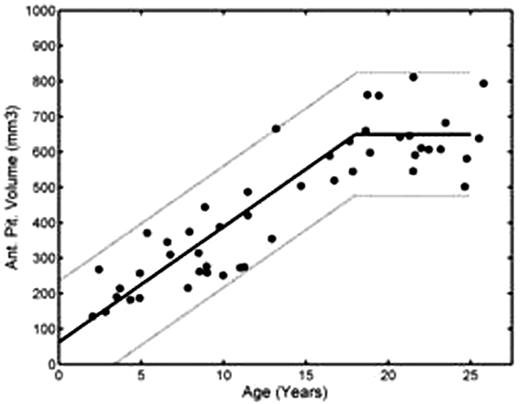Abstract
Abstract 4073
Poster Board III-1008
Despite continuing advances in iron chelation therapy, endocrine dysfunction is common in chronically transfused patients with iron overload. In thalassemia major, hypogonadotropic hypogonadism (HH), impaired glucose tolerance, delayed growth, and hypothyroidism are common, but gonadotrophic function is the most vulnerable and least reversible. Unfortunately, clinical effects of gonadotrophe iron toxicity are not detectable until puberty. Provocative GnRH stimulation can be used to detect preclinical HH, but it can be difficult to interpret in adolescents. Thus, surrogates for preclinical pituitary iron deposition and damage are imperative. MRI can be used to measure pituitary iron (R2) and volume, analogous to its use for the heart, liver, and pancreas. Increased pituitary R2 and decreased pituitary volume predict clinical and biochemical HH in adults with thalassemia major 1,2. However, to apply these techniques to prepubertal patients with iron overload, it is imperative to develop age-appropriate normative data for pituitary iron and volumes. The goal of this study was to determine trends/limits of pituitary R2 and volume in normal subjects between the ages of 2 and 25 years.
We studied 49 normal volunteers between the ages of 2 and 25 years old; informed consent was obtained in all examinations. Patients as young as four years of age were studied without anesthesia by using video goggles and appropriate coaching. Seven patients were studied under general anesthesia by adding the research MRI (< 10” duration) on to a clinically indicated sedated head MRI. All studies were performed on a 1.5 T Philips Achieva. Anterior pituitary R2 was assessed in the sagittal and coronal planes using a multi-echo spin echo sequence using eight echoes from 15 to 120 ms, five mm thick slices, 1 mm2 inplane resolution, and repetition time (TR) of 500 ms. Pituitary volume was assessed using a 3D spoiled gradient echo sequence with 1 mm3 isotropic voxels, TR 7.2 ms, echo time 3.3 ms, and flip angle of eight degrees.
Pituitary R2 was calculated by pixelwise fitting to a monoexponential without a background offset. Regions of interest incorporating the anterior pituitary were manually traced, with mean and median values were used to represent the overall gland R2. All contours were confirmed by a board certified neuroradiologist. Piecewise linear regression was used to describe anterior pituitary volume, while R2 values were well described by simple linear regression. All statistics were performed using JMP5.1 (SAS, Cary, NC).
Anterior pituitary volume increased linearly with age (Figure 1, left) and plateaued at 18 years of age. Normalization with respect to age produced lower variability than normalization with respect to height, weight, and body surface area. No gender differences were observed. Posterior pituitary volume also increased with age but appeared larger in mid puberty than in adulthood (not shown). Sagittal and coronary pituitary R2 increased linearly (r2 = 0.10 and 0.38, p = 0.03 and < 0.001) with age throughout the study interval (Figure 1, right). Mean and median R2 values were unbiased and highly correlated (r2 = 0.93) with one another but median values were more robust to outliers. Pituitary R2 estimates in the sagittal and coronal planes were not statistically equivalent. Sagittal R2 values exhibited a bias of -3% that increased with R2 value. Limits of agreement were ± 20%. With respect to age-normalization, coronal R2 values exhibited 31% lower variability than sagittal images.
Pituitary R2 values and pituitary volumes are age-dependent. Coronal R2 estimates were slightly higher and had lower variability than values calculated in the sagittal plane. This likely reflects the larger and more homogeneous sampling area in coronal pituitary views. Nomograms from these data will improve recognition of preclinical pituitary iron loading and volume-loss in iron overloaded patients. Additional subjects will be necessary to resolve peripubertal changes in posterior pituitary volume, trends in early adulthood, and gender or ethnicity differences.
Coates:Novartis: Consultancy, Honoraria, Research Funding, Speakers Bureau. Wood:Novartis: Research Funding.
References
Author notes
Asterisk with author names denotes non-ASH members.



This feature is available to Subscribers Only
Sign In or Create an Account Close Modal